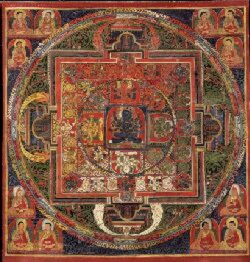Five wisdoms
Five wisdoms (Tib. ཡེ་ཤེས་ལྔ་, yeshe nga; Wyl. ye shes lnga) — five aspects of primordial wisdom (Tib. ཡེ་ཤེས་, yeshe). They are as follows:
- wisdom of dharmadhatu; Wisdom of the Embodied Nature of Dharma Realm - derived from amala-vijanana, i.e. pure consciousness (or mind)
- mirror-like wisdom; Wisdom of the Great Round Mirror - derived from alaya-vijanana, (8th consciousness) reflecting all things.
- wisdom of equality; Wisdom in regard to all things equally and universally - derived from manovijanana (7th consciousness).
- wisdom of discernment; Wisdom of profound insight, or discrimination, for exposition and doubt - destruction - derived from the mind consciousness (6th consciousness).
- all-accomplishing wisdom; Wisdom of perfecting the double work of self welfare and the welfare of others - derived from the five senses (1st to 5th consciousness).
Sogyal Rinpoche writes:
- You can also think of the nature of mind like a mirror, with five different powers or 'wisdoms.' Its openness and vastness is the wisdom of all-encompassing space [or dharmadhatu), the womb of compassion. Its capacity to reflect in precise detail whatever comes before it is the mirror-like wisdom. Its fundamental lack of any bias toward any impression is the equalizing wisdom [or wisdom of equality). Its ability to distinguish clearly, without confusing in any way the various different phenomena that arise, is the wisdom of discernment. And its potential of having everything already accomplished, perfected, and spontaneously present is the all-accomplishing wisdom. (The Tibetan Book of Living and Dying, p. 157)
These five wisdoms may be condensed into two:
- ‘the wisdom that knows the nature of all phenomena’ which comprises the wisdom of the dharmadhatu, mirror-like wisdom and the wisdom of equality; and
- ‘the wisdom that knows the multiplicity of phenomena’ which comprises discriminating and all-accomplishing wisdom.
They can all be condensed into a single wisdom: the wisdom of omniscience.
Further Reading
- Khenpo Ngawang Palzang, A Guide to the Words of My Perfect Teacher (Boston & London: Shambhala, 2004), pages 104-105.
Source
Five wisdoms (ye shes lnga). The dharmadhatu wisdom, mirror-like wisdom, wisdom of equality, discriminating wisdom, and all-accomplishing wisdom. They represent five distinctive functions of the tathagatagarbha, our enlightened essence.
The Five Wisdoms (Sanskrit: pañca-jñāna; Tibetan: ཡེ་ཤེས་ལྔ, Wylie: ye shes lnga; Japanese: go-chi) is an upāya or 'skillful means' doctrine of Mahayana Buddhism. The Five Wisdoms may be understood as the indivisible 'continum of bodhi ' (Sanskrit: citta santana), especially according to Yogācarā based Mahāyāna doctrines, ultimately derived from the Buddhabhūmi Sūtra.
Five wisdoms; pancajnana (Skt); ye shes lgna (Tib).
The five wisdoms are:
- (1) Pristine cognitions of reality (dharmadhatujnana);
- (2) mirror-like pristine cognition (adharshajnana);
- (3) the pristine cognition of sameness (samatajnana);
- (4) pristine cognition of discernment (pratyavekshanajnana)
- (5) pristine cognition of accomplishment (krityupasthanajnana).
Four reliances; rton pa bzhi (Tib).
Capriles (2003: p. 197) in discussing the 'view' (Sanskrit: drishti) of the Inner Tantras of the Third Turning of the Dharmachakra states that:
- Concerning the principally “inner” or “outer” character of the teachings contained in sutras of the Third Promulgation, definitively the more “inner” ones are those that teach that all that manifests or appears, either as subject or as object, is based on primordial gnosis (Skt., jñana; Tib., yeshe {ye-shes}) rather than on mind, and that emphasize the fact that consciousness is a conditioned, delusive, impermanent appearance that disappears upon Awakening.
Five Wisdoms
Wisdom of the Embodied Nature of Dharma Realm
- derived from amala-vijanana, i.e. pure consciousness (or mind).
Wisdom of the Great Round Mirror
- derived from alaya-vijanana, (8th consciousness) reflecting all things.
Wisdom in regard to all things equally and universally
- derived from manovijanana (7th consciousness).
Wisdom of profound insight, or discrimination, for exposition and doubt - destruction
- derived from the mind consciousness (6th consciousness).
Wisdom of perfecting the double work of self welfare and the welfare of others
- derived from the five senses (1st to 5th consciousness).
In the quotation mentioned above, "consciousness" is to be understood as an English rendering of vijñāna (Sanskrit) as in the Eight Consciousnesses and "all that manifests or appears" is to be understood as 'phenomena' or dharmas (Sanskrit) in Buddhist phenomenology. Jñāna (Sanskrit) is rendered into English as 'primordial gnosis'. In addition, for clarity "mind" in this instance is an English rendering of citta (Sanskrit) that may be viewed as either 'absolute' and/or 'relative' according to the Doctrine of the Two Truths. "Awakening" is an English rendering of bodhi (Sanskrit).
Nomenclature, orthography and etymology
Pañca-jñāna is orthographically rendered into English as: Five Wisdoms, Five Awarenesses, Five Pristine Cognitions.
Pañca-jñāna
The pañca-jñāna are:
Tathatā-jñāna
Keown, et al. (2003) hold that the Tathatā-jñāna is the jñāna of Suchness or Dharmadātu, "the bare non-conceptualizing awareness" of Śūnyatā, the universal substrate of the other four jñāna.
Ādarśa-jñāna
The Melong is very important in the esoteric Mantrayana traditions such as Dzogchen. Keown, et al. (2003) hold that the Ādarśa-jñāna is the jñāna of "Mirror-like Awareness", "devoid of all dualistic thought and ever united with its 'content' as a mirror is with its reflections". Ādarśa is Sanskrit for "mirror", the term may be parsed into the etymon of darśana with a grammatical adposition.
Kalupahana (1991: p. 99) proffers that:
- Samatā is also identical with the second ādarśa when samatā becomes the non-duality of upāya and prajñā.
Samatā-jñāna
Keown, et al. (2003) hold that the Samatā-jñāna is the jñāna of the "Awareness of Sameness", which perceives the sameness, the commonality of dharmas or phenomena.
Kalupahana (1991: p. 99) proffers that:
- The Tattvāloka says "The wisdom of equality of Tathāgata is the non-dual method of upāya and prajñā, and it is the wisdom of the universal that can be tasted in the dharmādhatu."
Pratyavekṣaṇa-jñāna
Keown, et al. (2003) hold that the Pratyavekṣaṇa-jñāna is the jñāna of "Investigative Awareness", that perceives the specificity, the uniqueness of dharmas.
Kṛty-anuṣṭhāna-jñāna
Keown, et al. (2003) hold that the Kṛty-anuṣṭhāna-jñāna is the jñāna of "Accomplishing Activities", the awareness that "spontaneously carries out all that has to be done for the welfare of beings, manifesting itself in all directions".
Historical development of the Five Wisdoms
Emergence of Pañca-jñāna
Kalupahana (1991: p. 99) in drawing together the Buddhabhūmi-sutra, Buddhabhūmi-vyākhyāna, Śilabhadra, Tathāgata, upāya, prajñā, nonduality, Tattvasaṃgraha, Tattvāloka, svabhāva, dharmadhātu, Bhāvanākrama, nirmāṇakāya, sambhogakāya and dharma-kāya and the Five Wisdoms states:
- The idea that upāya and prajñā are non-dual is also expressed in the commentary on the Tattvasaṃgraha. The Tattvāloka says "The wisdom of equality of Tathāgata is the non-dual method of upāya and prajñā, and it is the wisdom of the universal that can be tasted in the dharmādhtu." In the Chinese version of the Bhāvanākrama, there is a final section outlining the relationship between the three-fold buddha-kāya and the five-fold wisdom of the Tathāgatas.
The five-fold wisdom of the Tathāgatas are dharmadhātu-svabhāva, ādarśa, samatā, pratyavekṣaṇa, and kṛtyānusthāna. Each type of wisdom is associated with five Buddhas, i.e.,
- dharmadhātu-svabhāva with Mahāvairocana,
- ādarśa with Akṣobhya,
- samatā with Ratnasambhava,
- pratyavekṣaṇa with Amitāyus, and
- kṛtyānusthāna with Amoghasiddhi.
Kamalasila further explains that the first two forms of wisdom (dharmadhātu-svabhāva and ādarśa) belong to dharma-kāya, samatā and pratyavekṣaṇa to sambhogakāya, and the last kṛtyānusthāna to nirmāṇakāya.
The theory of the five-fold wisdom and its relation to the Buddha-kāya was originally formulated in the Buddhabhūmi-sutra and the Buddhabhūmi-vyākhyāna by Śilabhadra.
Five Wisdoms and the Six Perfections
Kalupahana (1991: p. 99) in linking the Six Perfections, upāya, prajñā and mokṣa proffers that:
- Kamalasila concluded that the first five perfections correspond to the upāya and the last to prajñā. When upāya and prajñā are perfectly united, then mokṣa or perfect liberation of mind will result.
Yogācāra refinement of the Pañca-jñāna
Keown, et al. (2003) identify a relationship between the Pañca-jñāna and the Eight Consciousnesses of Yogācāra thought: the Pañca-jñāna "emerge through a transformation (parāvṛtti) of the eight consciousnesses at the moment of enlightenment".
Vajrayana Buddhism
Keown, et al. (2003) identify that the Pañca-jñāna "underwent a considerable development" within Tibetan Buddhism where they are "symbolized or embodied" in the Five Jinas.
In elucidating the Twilight Language, Tenzin Wangyal holds that the Five Pure Lights become the Five Poisons if we remain deluded, or the Five Wisdoms and the Five Buddha Families if we recognize their purity.
Iconographic representation: Vajrayana
The 'symbolic bone ornaments' (Skt: aṣṭhiamudrā; Tib: rus pa'i rgyanl phyag rgya), known as "mudra" or 'seals' are listed variously and comprise or number five or six in different traditions and tantras. The Hevajra Tantra associates the Symbolic Bone Ornaments directly with the Five Wisdoms and these are elucidated by a commentary to the Hevajra Tantra by Jamgön Kongtrul:
- the 'wheel-like' (Tib.: 'khor lo) 'crown ornament' (sometimes called 'crown jewel') (Tib.: gtsug gi nor bu), symbolic of Akshobhya and 'mirror-like pristine awareness' (Ādarśa-jñāna);
- 'earings' (Tib.: rna cha) representent of Amitabha and pristine awareness of discernment (Pratyavekṣaṇa-jñāna);
- 'necklace' (Tib.: mgul rgyan) symbolizing Ratnasambhava and pristine awareness of total sameness (Samatā-jñāna);
- 'bracelets' (Tib.: lag gdu) and 'anklets' (Tib.: gdu bu) as symbolic of Vairochana and pristine awareness of the ultimate dimension of phenomena (Tathatā-jñāna);
- 'girdle' (Tib.: ske rags) symbolizing Amoghasiddhi and the accomplishing pristine awareness (Kṛty-anuṣṭhāna-jñāna);
- The additional ornament spoken of in various texts related to Hevajra is ash from a cremation ground smeared on the body (Tib.: thal chen).
ye shes lnga - five wisdoms [RY]
ye shes lnga - the five wisdoms. {me long, lta bu} mirror [like] wisdom, {mnyam nyid} equality wisdom, {so sor rtog pa} discriminating wisdom, {bya grub} accomplishing wisdom, {chos dbyings} expanse of qualities wisdom, five aspects of pristine awareness;
Five Kinds of Pristine Cognition. Five wisdoms. The pristine cognition of the expanse of reality {chos dbyings kyi ye shes} or dharmadhatu jñana. the mirror-like pristine cognition {me long gi ye shes} or adarsha jnana. the pristine cognition of discernment {sor rtog pa'i ye shes} or pratyavekshana jnana. the pristine cognition of sameness {mnyam nyid kyi ye shes} or samata jnana. and the pristine cognition of accomplishment {bya ba'i ye shes} or k.rtyanusthana jnana.
five types of fruition awareness, the five wisdoms.
1) chos dbyings} or {chos kyi dbyings kyi ye shes}.
2) {me long} or {me long lta ba'i ye shes}
3) {mnyam nyid} or {mnyam pa nyid kyi ye shes}
4) {sor rtog} or {so sor rtog pa'i ye shes}
5) {bya grub} or {bya ba grub pa'i ye shes} [RY]
ye shes lnga - five types of fruition awareness, the five wisdoms [IW]
ye shes lnga - five wisdoms (chos dbyings ye shes, me long ye shes, mnyam nyid ye shes, so sor rtog pa'i ye shes,bya grub ye shes) [JV]
ye shes lnga'i dbyings kyi snang ba - the experience / manifestation of the space of the five wisdoms
Source
- 1. gnosis or dharmadhatu
- 2. mirror-like
- 3. equality
- 4. discrimination
- 5. all-accomplishing
- 1 Wisdom of the Embodied Nature of Dharma Realm - derived from amala-vijanana, i.e. pure consciousness (or mind).
- 2 Wisdom of the Great Round Mirror - derived from alaya-vijanana, (8th consciousness) reflecting all things.
- 3 Wisdom in regard to all things equally and universally - derived from manovijanana (7th consciousness).
- 4 Wisdom of profound insight, or discrimination, for exposition and doubt - destruction - derived from the mind consciousness (6th consciousness).
- 5 Wisdom of perfecting the double work of self welfare and the welfare of others - derived from the five senses (1st to 5th consciousness).






